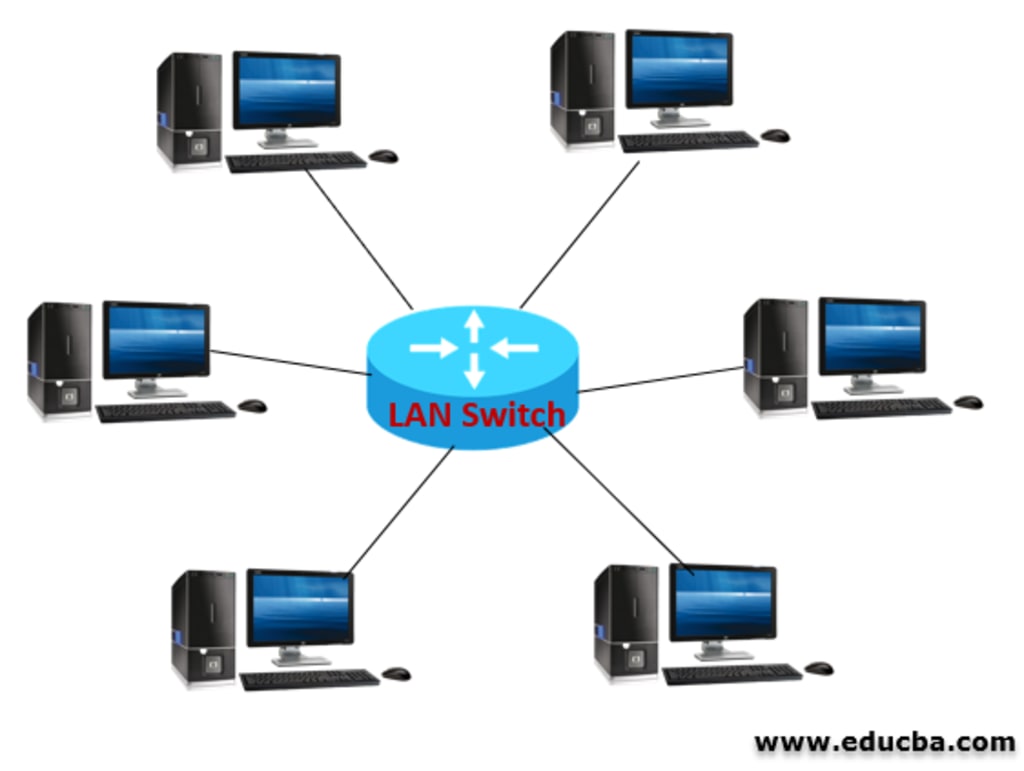
A switch is a device used in computer networking that connects devices together on a local area network (LAN). It is a networking hardware device that operates at the data link layer (Layer 2) of the OSI (Open Systems Interconnection) model.
Switches are used to direct network traffic between devices by forwarding data packets only to the intended recipient device. They do this by examining the destination MAC (Media Access Control) address of each packet and forwarding it to the appropriate port that connects to the destination device. This allows multiple devices on the same network to communicate with each other simultaneously and efficiently.
Switches are often used in place of hubs, which are less efficient and send all network traffic to all connected devices, resulting in more collisions and slower data transmission. Switches can be managed or unmanaged, with managed switches offering more advanced features such as VLAN (Virtual Local Area Network) support and Quality of Service (QoS) controls.
There are several types of switches used in computer networking, including:
Unmanaged Switch: An unmanaged switch is a basic switch that operates without any configuration required. It is typically used in small networks with a few devices and does not have any advanced features.
Managed Switch: A managed switch is a switch that can be configured and monitored to provide more advanced features such as VLANs, QoS, and security protocols. They are typically used in larger networks where advanced features and monitoring are required.
Gigabit Switch: A gigabit switch is a switch that supports gigabit Ethernet speeds (1 Gbps) and is used in networks where high-speed data transfer is required.
Power over Ethernet (PoE) Switch: A PoE switch is a switch that provides power over Ethernet to connected devices, such as IP cameras and wireless access points, eliminating the need for separate power supplies.
Layer 2 Switch: A Layer 2 switch operates at the data link layer of the OSI model and forwards data packets based on MAC addresses.
Layer 3 Switch: A Layer 3 switch operates at the network layer of the OSI model and can route data packets based on IP addresses, making it more efficient than a Layer 2 switch for larger networks.
Stackable Switch: A stackable switch is a switch that can be connected with other switches to create a single virtual switch with higher port density and improved management capabilities.
Cloud-managed Switch: A cloud-managed switch is a switch that can be managed and monitored through a cloud-based management interface, making it easier to manage remote networks.
Advantages of Switches
Switches are important networking devices that provide several advantages over other network devices like hubs and routers. Some of the key advantages of switches include:
Efficient data transfer: Switches are capable of transferring data between devices more efficiently than hubs. Switches create a direct connection between the devices on the network, enabling faster data transfer rates and reducing network congestion.
Improved network performance: Switches can segment networks into smaller parts, thereby reducing the amount of traffic that needs to traverse the network. This helps to improve network performance and reduce the risk of network downtime.
Enhanced security: Switches provide better security than hubs since they can use features like VLANs (Virtual Local Area Networks) to isolate traffic from different devices. This reduces the risk of unauthorized access and helps protect sensitive data.
Flexibility: Switches are highly flexible and can be easily configured to meet the specific needs of a network. This includes setting up VLANs, managing traffic flow, and configuring Quality of Service (QoS) settings to prioritize certain types of traffic.
Overall, switches provide a range of benefits that make them a valuable networking tool for businesses of all sizes.
Disadvantaged of switch
Assuming you are referring to "switch" in the context of computer networking, here are some disadvantages of using switches:
Cost: Switches are generally more expensive than hubs, which are an alternative networking device that broadcasts data to all connected devices. This is because switches are more sophisticated and offer greater control over data flow.
Complexity: Switches can be more complex to set up and configure than hubs. They require more knowledge of networking protocols and techniques, which can be a disadvantage for novice users.
Limited scalability: While switches can handle more data than hubs, they can still be limited in terms of scalability. Switches typically have a limited number of ports, and if you need to add more devices to your network, you may need to purchase additional switches.
Vulnerability to security threats: Switches can be vulnerable to security threats, such as attacks that target the switch's firmware or operating system. These attacks can disrupt network traffic and compromise the security of connected devices.
Single point of failure: Switches can be a single point of failure in a network. If a switch fails, all devices connected to that switch may lose connectivity until the switch is replaced or repaired.
It is worth noting that while switches have some disadvantages, they are generally considered a superior option for network connectivity compared to hubs. Switches provide better performance, security, and scalability, which can be important for businesses and organizations that rely on their network infrastructure.
Advance of switch
Switches are a fundamental component in computer networking and are used to connect devices within a local area network (LAN). They have advanced significantly over the years and have become much faster, more reliable, and feature-rich.
Here are some of the advances of switches:
Speed: Switches have become much faster than their predecessors, hubs. Modern switches can handle data transfer speeds of 10Gbps, 40Gbps, and even 100Gbps, which makes them suitable for high-bandwidth applications.
Virtual LAN (VLAN): Switches can segment a network into multiple virtual networks, or VLANs, which can be used to improve network security, performance, and management. VLANs can be used to separate traffic, control access to resources, and improve network performance by reducing broadcast traffic.
Quality of Service (QoS): Switches can prioritize network traffic based on the type of traffic, source, or destination. QoS can be used to ensure that critical traffic, such as VoIP, is given higher priority than less important traffic, such as file transfers.
Power over Ethernet (PoE): Switches can provide power to network devices over Ethernet cables, eliminating the need for separate power supplies. This is especially useful for devices such as IP phones, wireless access points, and security cameras.
Management: Modern switches can be managed remotely, allowing network administrators to configure, monitor, and troubleshoot switches from a central location. This makes it easier to manage large and complex networks.
Redundancy: Switches can be configured to provide redundancy and failover, ensuring that network traffic can continue to flow even if a switch or link fails.
Overall, switches have evolved significantly over the years and have become an essential component in modern computer networks. They provide the foundation for reliable, high-performance network connectivity and help to improve network security, manageability, and scalability.





Comments
There are no comments for this story
Be the first to respond and start the conversation.